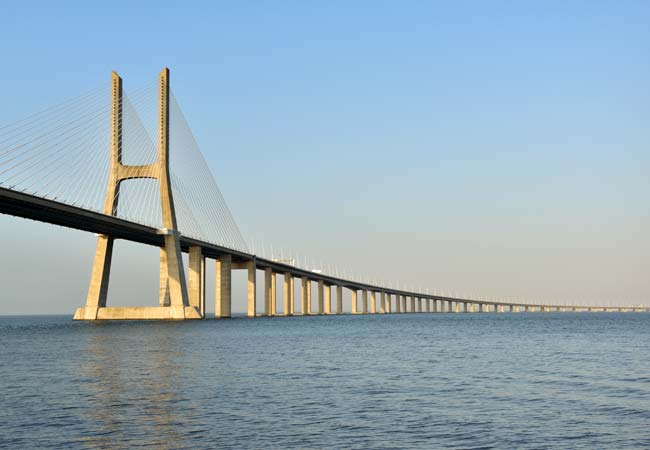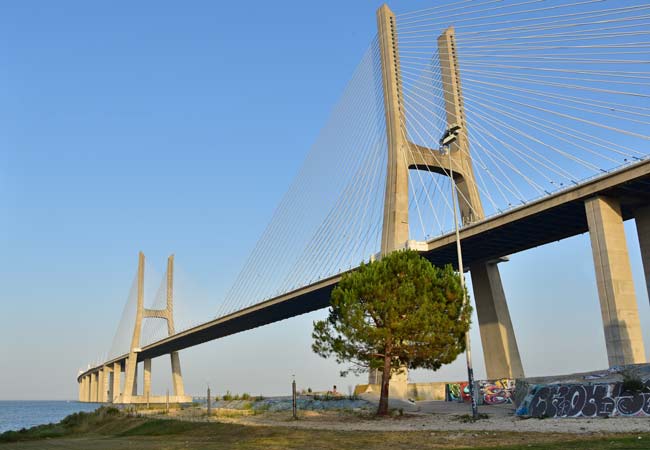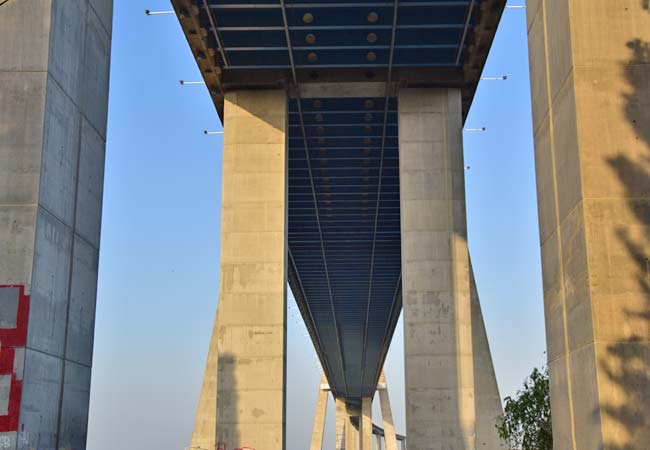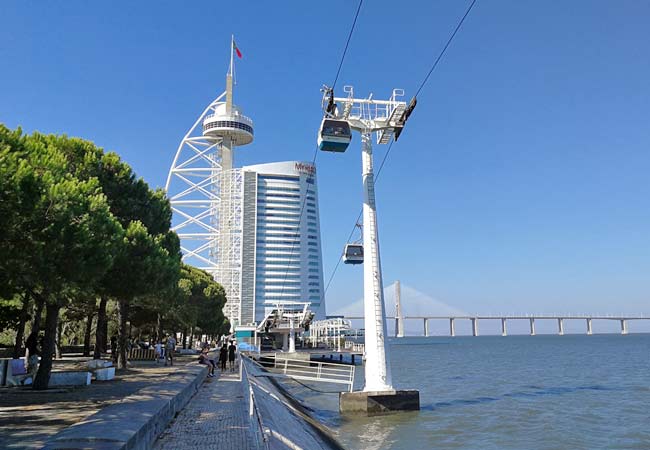LisbonLisboaPortugal.com
The best independent guide to Lisbon
LisbonLisboaPortugal.com
The best independent guide to Lisbon
The Ponte Vasco da Gama bridge, Lisbon; a tourism guide
The Ponte Vasco da Gama Lisbon is the longest bridge in Portugal, and the 17km length spans the Tejo Estuary to the east of Lisbon. When it was inaugurated in 1998, it was the longest bridge in Europe and is named after Portugal’s great explorer Vasco da Gama.
The Ponte Vasco da Gama is certainly not as charismatic as Lisbon’s other bridge, the golden arched Ponte 25 de Abril, but its sheer size and length that stretches out into the horizon is an engineering marvel.

Ponte Vasco da Gama extending as far as the eye can see across the shallow Tejo Estuary
Ponte Vasco da Gama tourist information
The Ponte Vasco da Gama carries the A12 expressway and crosses the Tejo Estuary in an east-west direction. There are no pedestrian footpaths on the bridge, and there is no way to cross the bridge on foot or by cycle.
The Vasco da Gama bridge is a toll bridge, and the toll is paid on entering Lisbon (heading west). There is no toll when leaving Lisbon (heading east), and was designed to reduce traffic levels in the city.
The Vasco da Gama bridge toll is €3.20 for a car, or €7.15 for a van or campervan. The toll can be paid by cash or debit cards, and the toll booths are operated by staff. The Vasco da Gama toll (€3.20) is more than the Ponte 25 de Abril toll, which costs €2.10 for a car.
Cash is always the best method, as foreign bank cards can sometimes be problematic (American Express is not widely accepted).
Full details of the tolls can be found on the Luso Ponte website: www.lusoponte.pt

The double arches of the main bridge, and the only section which is navigable for large boats
The payment can also be made using 'Via Verde', which is used to pay automatically for the toll expressways in Portugal. The Via Verde transponder is attached to your windscreen and linked to your bank account, automatically paying the tolls when passing through one of the Via Verde toll gates. If you have a rental car, it may have come with the Via Verde transponder already installed. It is highly recommended to have the Via Verde if you are doing any long-distance driving in Portugal.
Further information can be found on the Via Verde website: https://viaverde.pt/
The Ponte Vasco da Gama has significantly less traffic than the Ponte 25 de Abril, and is always the better option to cross the Tejo Estuary. If you are travel to or from the south of Portugal (Setubal or further south), the Ponte Vasco da Gama is the better option to leave or enter Lisbon.
There can be horrendous traffic on the Ponte 25 de Abril at rush hour or when everyone is returning from the beach. The Ponte Vasco da Gama may be more expensive, but it will always be faster.
The bridge can not be crossed but the base of the bridge can be visited, and stands at the northern end of the Parque das Nações. This district is the ultra-modern side of Lisbon, with lots of good tourist sights and attractions.
Related articles: Ponte 25 de Abril - Parque das Nações
Is the Ponte Vasco Gama earthquake proof?
Lisbon lies within a possible seismic activity region, and the Ponte Vasco da Gama had to withstand a major earthquake.
The foundations of the Vasco da Gama viaducts extend down 95 meters into the bedrock while the pillars were reinforced to support winds of 155mph (250km/h). The architects of the Ponte Vasco da Gama were quoted stating that the bridge would withstand an earthquake 4 times of that of the 1755 earthquake.

Below the colossal concrete supports is the pretty Parque Tejo
History of the Vasco Gama Bridge Lisbon
Lisbon has always been plagued with traffic issues. During the mid 90s travelling south out of Lisbon become intolerable with the 6 lane Ponte 25 de Abril simply unable to handle the volumes of commuters.
Suggestions for a new bridge had been bounced around for decades but the distance to traverse, poor foundations and possibility of seismic activity had always pushed the construction costs beyond that of which the government could afford.
The hosting of the world fair in 1998 (Expo 98) necessitated the second bridge and a novel way to fund the bridge was devised, which would cost the Portuguese taxpayers absolute nothing.
Related articles: Expo 98'

The Ponte Vasco da Gama as seen from the Parque das Nações, the former Expo 98’ site
The Portuguese government tended the building, maintenance and, most importantly, the collection of the road tolls to private companies, who would be able to raise the estimated 1 billion dollars to construct the bridge.
A private consortium, Lusoponte, agreed to build the bridge but hold exclusive control of toll collection for both of Lisbon’s bridges for 40 years.
With the funding organised, the bridge was constructed in an unbelievable short time period of only 18 months, which coincided with the opening of Expo 98.
The 17km length of the bridge was divided into four sections, with each section being built by different private engineering companies that were overseen by Lusoponte.
At the height of construction, over 3,000 people were employed, this combined with the 2,500 who worked on the expo site resulted in the largest construction project in Portugal during the 21st century.
Interesting facts about the Ponte Vasco Gama bridge
The final bridge was expensive, strong and very long. The Ponte Vasco da Gama’s official length was 17.2 km (10.7 miles), and at the time of the inauguration on the 29th March 1998, it was the longest bridge in the world, and today is still Europe’s longest bridge over an expanse of water.
On the inauguration day of the Ponte Vasco da Gama the residents of Lisbon were invited to a seated party that extended the length of the bridge. The opening of the bridge coincided with the opening of Expo 98 as thousands of Spanish and European tourists travelled to Lisbon from the east of the city.
The bridge has presently 6 lanes of traffic, but the original design allowed for further expansion when the capacity is required. The value presently set for enlargement is when the average number of cars exceeds 52,000 per day and is expected with the next 6 years. The Ponte 25 de Abril has upwards of 150,000 vehicles per day.
Discover more of Lisbon with our most popular guides
If you've found our content valuable, we'd welcome your support.
The digital publishing landscape has evolved significantly. As a small independent publisher, we face growing challenges. Search engines increasingly favour paid content over organic results, while AI-generated content often reproduces original work without attribution.
To support our work, please consider bookmarking this page (press Ctrl + D) for quick access. If you find an article helpful, we'd be grateful if you'd share it with friends on social media.
For specific questions, please see our Reddit community at r/LisbonPortugalTravel.
Should you notice any outdated or incorrect information, please contact us at [email protected]
Thank you for helping us continue to provide valuable content in an increasingly challenging digital environment.
A complete list of all of our Lisbon articles
If you've found our content valuable, we'd welcome your support.
The digital publishing landscape has evolved significantly. As a small independent publisher, we face growing challenges. Search engines increasingly favour paid content over organic results, while AI-generated content often reproduces original work without attribution.
To support our work, please consider bookmarking this page (press Ctrl + D) for quick access. If you find an article helpful, we'd be grateful if you'd share it with friends on social media.
For specific questions, please see our Reddit community at r/LisbonPortugalTravel.
Should you notice any outdated or incorrect information, please contact us at [email protected]
Thank you for helping us continue to provide valuable content in an increasingly challenging digital environment.































